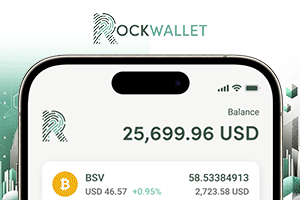|
Getting your Trinity Audio player ready...
|
PayPal (NASDAQ: PYPL) has announced the launch of “Pay with Crypto, powered by PayPal,” a new feature geared toward merchants that allows them to accept digital currency as a payment method without the usual headaches that can come with holding volatile digital assets.
“Pay with Crypto, powered by PayPal, connects merchants to a $3+ trillion market [and enables] instant crypto to stablecoin or fiat conversion,” the company said in its official announcement.
Although most of the action comes from consumers choosing to pay with digital currency, this is a merchant-facing feature that allows sellers to receive digital currency and instantly convert it to fiat or PYUSD, PayPal’s stablecoin pegged to the U.S. dollar.
To make the deal even sweeter, PayPal offers 4% APY on PYUSD holdings. That means if a merchant enables Pay with Crypto, receives revenue through it, automatically converts that digital currency to PYUSD, and just lets it sit, they will earn passive income on those funds.
PayPal’s digital currency tool cuts fees and grows merchant margins
In the announcement, PayPal lays out several reasons why merchants should care about Pay with Crypto. Ultimately, they boil down to the fact that digital currency transactions are faster and cheaper than what merchants are used to.
“With a transaction rate of 0.99%, Pay with Crypto decreases the cost of transactions by up to 90% when compared to international credit card processing,” the announcement says.
“Using PayPal’s open platform, [a] business can accept crypto for payments, increase their profit margins, pay lower transaction fees, get near-instant access to proceeds, and grow funds stored as PYUSD at 4% when held on PayPal,” added Alex Chriss, President and CEO of PayPal.
Even though PayPal is the latest company to roll out a digital currency-to-fiat conversion tool for merchants, a feature like this is not unheard of.
PayPal joins BitPay, Coinbase, and others
In 2018, BitPay announced it would let merchants settle in GUSD or USDC instead of BTC or BCH. Others like Coinbase (NASDAQ: COIN), Circle (NASDAQ: CRCL), and CoinGate offer similar features, allowing merchants to automatically convert digital currency payments to stablecoins or fiat.
It’s a valuable tool for merchants who want to accept as many payment options as possible without exposing their revenue to the volatility of digital currency markets. However, features like Pay with Crypto don’t really have value unless customers are actually paying in digital currency—and the data says that not many consumers are doing this.The digital currency payment problem: Nobody’s paying in digital currency
According to Politico, only 2% of U.S. adults have used digital currency to make a purchase, so even among those who hold digital currency, most don’t spend it. BitPay, a leading digital currency payment processor, reports that just 4% of digital currency holders have used BitPay to make purchases.
In other words, features like Pay with Crypto don’t matter much if nobody is paying in digital currency. Sure, the launch of these tools makes headlines, but real traction from real users ultimately moves these products and the industry forward. Right now, that user demand just isn’t there.
At the moment, there’s no real incentive to spend digital currency. Oftentimes, the risk outweighs the reward. Most digital assets trend upward over time—often by double or even triple-digit gains on a long enough timeline. So if you believe your assets are likely to appreciate, why would you use them to buy a product today?
Even digital currency history warns against doing this; the classic cautionary tale is Laszlo Hanyecz, who famously spent 10,000 BTC (around $41 at the time) on two Papa John’s pizzas in 2010. That 10,000 BTC would be worth roughly $1.18 billion at today’s prices. That is just one instance of someone paying in digital currency to their detriment; there are more stories of a person who makes a purchase in digital currency walking away regretful than there are of it being the right decision.
However, at least one reason someone might pay for a good or service in digital currency comes down to tax strategy. If users can transact directly in digital currency, especially for a large purchase, without converting to fiat, they might avoid triggering a capital gains event. In those cases, digital currency payments make sense. But those use cases are far and few in between. There isn’t enough upside for the average consumer to justify spending digital currency on everyday goods and services.
Consumers aren’t spending digital currency yet
PayPal’s Pay with Crypto might prove to be important one day; it solves a real merchant pain point and seamlessly integrates with the PayPal ecosystem. But until consumers start paying with digital currency in meaningful numbers, it’s a solution that will be used very infrequently.
Before a feature like this picks up meaningful traction, there will have to be a shift in demand from the consumer. The consumer will need to feel incentivized to spend their crypto. They will need to feel like spending their digital currency is better than spending their fiat. But until that shift comes, Pay with Crypto, powered by PayPal, is just a feature that most likely won’t be used very often, joining the incumbents like BitPay, Coinbase, and Circle, who offer merchants similar services.
Watch | Brandon Bryant: HandCash making payments seamless for digital goods users

 08-02-2025
08-02-2025 





